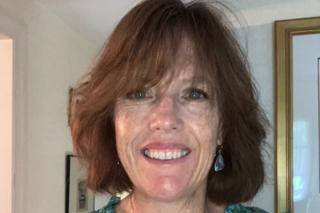As the United States shut down in the spring of 2020, all facets of life were impacted. Americans turned inward, and the home transformed into our restaurants, concert venues, movie theaters, and offices. For children, the home became a classroom. Although the many challenges of virtual learning are well documented, alumna Betsy Mull Balicao ‘93 chooses to focus on the unexpected benefits of a virtual year.
“I just try my best all the time,” says Balicao. “I try to be very flexible and try to make the best of situations. There have been bumps in all of our roads. It’s always been my choice to go for the positive and do the best you can given the situation.”
Balicao is the Reading Focus Teacher for Montgomery County Schools in Maryland. Teaching in the elementary school, she works with students individually or in small groups who need extra help with reading comprehension.
As with all schools, however, the pandemic forced districts to make changes across the board. Like many teachers, Balicao moved to where she was needed most.
It’s always been my choice to go for the positive and do the best you can given the situation.
“When the county decided we’d be virtual, it was very daunting, and I couldn’t imagine how it would work,” explained Balicao. “The principal had to prioritize and figure out what was most important. She decided that students should be able to read.”
Fortunately, the reading curriculum already had many materials online. Even while in person, Balicao was taking advantage of her online teaching resources. While virtual, she also taught first and second grade reading classes and hosted breakout rooms to lead small group reading.
“This was the chance for kids to read,” says Balicao. “It wasn’t perfect, but there was an improvement.”
Working from her basement, Balicao remembers how bizarre it felt to have everyone in the household consumed in their individual virtual worlds. Despite the oddities and challenges, Balicao found that virtual learning also led to something more meaningful: connection.
Now she was able to meet family members she hadn’t known, see beloved family pets, and learn about her students in different ways. More importantly, Balicao reconnected with former students — the older siblings of students attending her virtual classes.
“It was so exciting to see a student I had been very attached to in the background as I’m teaching his brother,” says Balicao. “It was such a positive moment.”
She discovered that computer screens weren’t just classrooms — they doubled as a window into everyone’s personal lives. It was through this virtual window that Balicao and a student found they shared something in common. Balicao’s daughter, Sara, has Down syndrome and would often be on-screen while she was teaching.
“This situation was very meaningful,” says Balicao. “One girl was falling behind in her reading, and she had a brother with Down syndrome. You could tell she was quite self-conscious about it — but here was my daughter joining me, so we had this connection. We would talk about how fun it is and how hard it can be. That was a really nice moment that virtual education allowed and wouldn’t have happened in a normal situation.”
That was a really nice moment that virtual education allowed and wouldn’t have happened in a normal situation.
Balicao encourages these conversations in an Ability Awareness Week that she helped establish at her school. Each classroom had a guest speaker with a visible or invisible disability speak about themself, how they maneuver through the world and what brings them joy. She believes that this is “an important way of allowing conversations about, and with people with disabilities in a safe space. In the end, students discover that all humans have similar needs and aspirations.”
“I especially wanted my sons to be able to talk about their sister with peers and for peers to be comfortable to ask questions,” explains Balicao. “I wanted Sara’s neighbors to better understand how to interact with her. At my school, most children did not have people with obvious disabilities around them. As I learned at Simmons in my education class, this is the most important time to expose students to difference — when they do not see it daily.”
Ultimately, Balicao wants her students to feel safe and supported — similar to how she felt at Simmons. Describing it as an intimate community, she felt empowered during her college years and “pushed in all the right ways; growing as a human being in ways I wanted to grow.”
Balicao carries these lessons into her current work. She loves watching her students grow and overcome their hurdles. By doing this, Balicao hopes to give her students agency over their lives and influence the future for the better.
“That’s why I like the intervention opportunities,” says Balicao. “A lot of times, I get the kids who were struggling and didn’t see themselves as readers — they didn’t see themselves as capable. I enjoy being that loving mirror saying, ‘Of course you can. You can do it — look what you just did!’ and getting them to believe in themselves.”

